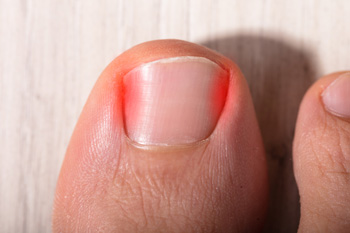

An ingrown toenail occurs when the edge of the nail grows into the surrounding skin, leading to discomfort and potential infection. Symptoms typically include redness, swelling, and pain surrounding the affected toenail. In more severe cases, there might be noticeable pus or a throbbing sensation. The condition often arises from factors such as wearing improperly fitting shoes, which place undue pressure on the toes, or incorrect nail trimming techniques, which can cause the nail to grow inward. Other contributing factors include genetic predisposition and trauma to the toe. Proper nail care, including trimming nails straight across and wearing well-fitted shoes, is essential in preventing ingrown toenails. An ingrown toenail can cause consistent pain and discomfort. If this applies to you, it is strongly suggested that you consult a podiatrist who can determine what the best course of treatment is for you, which may include minor surgery for removal.
Ingrown toenails may initially present themselves as a minor discomfort, but they may progress into an infection in the skin without proper treatment. For more information about ingrown toenails, contact Dr. Edward D. Hutson of Easton, PA. . Our doctor can provide the care you need to keep you pain-free and on your feet.
Ingrown Toenails
Ingrown toenails are caused when the corner or side of a toenail grows into the soft flesh surrounding it. They often result in redness, swelling, pain, and in some cases, infection. This condition typically affects the big toe and may recur if it is not treated properly.
Causes
You are more likely to develop an ingrown toenail if you are obese, have diabetes, arthritis, or have any fungal infection in your nails. Additionally, people who have foot or toe deformities are at a higher risk of developing an ingrown toenail.
Symptoms
Some symptoms of ingrown toenails are redness, swelling, and pain. In rare cases, there may be a yellowish drainage coming from the nail.
Treatment
Ignoring an ingrown toenail can have serious complications. Infections of the nail border can progress to a deeper soft-tissue infection, which can then turn into a bone infection. You should always speak with your podiatrist if you suspect you have an ingrown toenail, especially if you have diabetes or poor circulation.
If you have any questions, please feel free to contact our offices located in Easton, and Northampton, PA . We offer the newest diagnostic and treatment technologies for all your foot care needs.